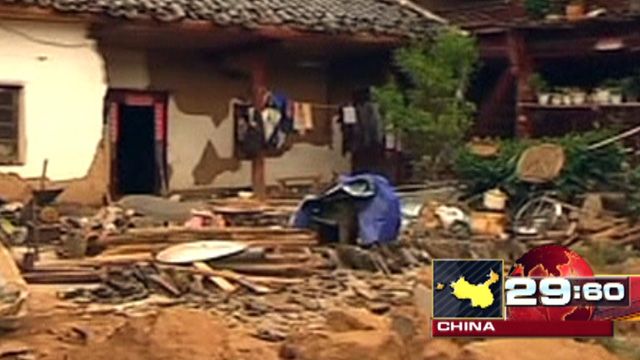Preparing Can Make Earthquakes Less Jolting
Earthquakes strike without warning, so the best (and only) way to protect yourself, your family and your home is to prepare ahead of time.
Earthquakes most commonly occur along the Pacific Coast, and residents of California face the greatest risk. But smaller earthquakes happen elsewhere in the U.S., such as the Virginia quake last year that rippled up and down the East Coast, or the 5.6-magnitude earthquake that hit Oklahoma in October, breaking records for the state.
Here are some tips on how to prepare before an earthquake hits, how to react during one, and how to pick up the pieces when the shaking stops.
Your Home's Structural Integrity
Which homes do best in earthquakes? Wood-frame houses withstand shaking better because they can flex with the movement, while brick or masonry homes are susceptible to cracking, says Jim Whittle, chief claims counsel at the American Insurance Association. To strengthen structures, homeowners can reinforce the connections -- foundation to walls and walls to roof -- with strappings or trusses, he says.
Most homes built after 1979 in quake-prone California have been constructed to a stricter earthquake building code so that they will withstand shaking better than older ones. But that means older homes, or those constructed outside the state, may be more vulnerable to quake damage.
Homeowners concerned about quakes should consult a contractor or engineer to see if their foundation (including crawl spaces) is secure and if any large first-floor openings (such as a garage door) are braced well, according to the website of California's Earthquake Country Alliance.
Inside Your Home
Simple precautions on the interior may save lives, since many quake deaths in the U.S. occur when furniture or heavy items topple over. For example, in the 1994 Northridge earthquake in California that measured a 6.7 magnitude, 55% of the injuries were caused by falling objects. Rarely do buildings crumble the way they do in lesser developed nations.
Quake precautions are like baby-proofing, says Glenn Pomeroy, CEO of the California Earthquake Authority. Tall, heavy furniture and appliances should be anchored to studs in the wall with nylon straps. Electronics can also be secured with buckles or straps. Use earthquake-proof picture hooks that secure wall hangings better, Pomeroy suggests, and avoid hanging hefty pictures or mirrors over beds and sofas.
"You don't want those things to come flying off the wall when people are sitting under them," he says.
Put heavy or breakable items on lower shelves, and secure smaller items with museum putty (also known as earthquake gel), according to the Earthquake Country Alliance website. Use special latches to keep cabinet doors, especially overhead ones, from opening and spilling their contents.
Anchor a water heater to the wall studs with metal straps. It’s best to ask your plumber to install flexible water and gas connectors to avoid busted pipes, according to the Earthquake Country Alliance website.
Finally, keep a flashlight and shoes under your bed for nighttime evacuation. Make a disaster kit for your family for the aftermath.
Safe Places to Go
Make sure every family member can identify a place to take cover in each room in the house, says Quvondo Johnson, inspector at the Los Angeles County Fire Department.
The safest places are under sturdy desks or tables. In an earthquake, you should drop to the floor, take cover under the table or desk, and hold on to one of the legs. Be prepared to move with the furniture until the shaking stops.
If there isn't a table or desk nearby, sit with your back against an interior wall, covering your head and neck for protection, according to the Earthquake Country Alliance. Stay away from windows, tall furniture and heavy wall hangings. If you're in bed, stay there until the shaking stops.
"If you're inside, you don't want to automatically run outside because you don't know what you're running into," Johnson says.
The reverse also is true, he says. If you're outside, move to an open space away from power lines and trees. If you're in a car, pull over -- but don't stop under an overpass or power lines, he says.
"Stay put and ride it out," says Johnson.
When the Shaking Stops
Smart reactions also are important after an earthquake, to keep your family and home safe. First, make sure you and family members aren't injured, and then go outside, moving carefully away from damaged buildings, trees and debris to a prearranged meeting place. Aftershocks can cause more damage and put you in danger. If you're by the ocean and the earthquake was substantial, move to higher ground in case it triggered a tsunami.
If you're trapped under debris, use a whistle or cellphone to signal for help. If you don't have these, tap on a wall or pipe three times every few minutes, so rescuers can locate you. Don't yell, so that you'll conserve energy and won't breathe in dust.
Once you and your loved ones are secure, assess your home for damage. Know where the utility shut-offs for gas, water and electricity are located in your home, and how to turn them off. Keep any necessary tools near the valves and switches.
"Check for gas leaks, ruptured water lines or sewers, and electrical wiring damage," says Chris Hackett, director of personal lines policy at Property Casualty Insurers Association of America. Turning off utilities is "an effective way to prevent even more damage from fire or water."
